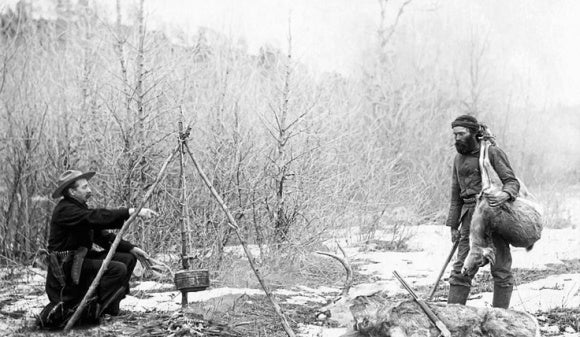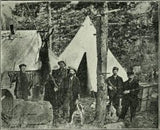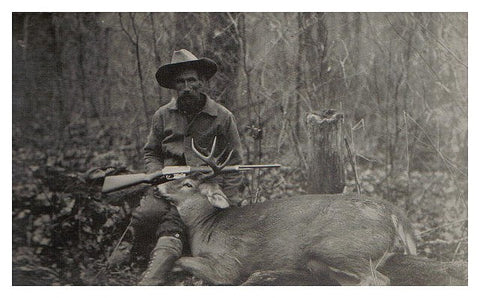Jack Pine Savage Venison Steak Recipe
Nov 04, 2014

When a man has been hard at work he feels more than just hungry, he feels as though he deserves a meal. When a man gets to that point, the quality of the meal can make or break his spirits. The Jack Pine Savages, the men who worked as lumber jacks deep in the northern woods, knew this as well as any man. Because their supplies were limited and they relied heavily on game meat they procured themselves, they became substantial cooks, knowing that a good meal would go a long way in setting a good mood for the camp.
I first learned about the term Jack Pine Savage reading through the Professional Guide’s Manual. It is there that I also found a few venison recipes that sound great and thought I would pass along. I haven’t tried these myself so I can’t provide my opinion on them, but hope to test them out when I get another batch of venison in the freezer.
Here are some pictures of a few men and their deer from the days of the Jack Pine Savage. I love the old pictures, particularly because the men just had rifles and plain clothes. Nothing fancy going on here, but they could take down a gene pool of deer. In most of the images I have seen of white-tailed deer hunters from the turn of the 20th century, they seemed to be partial to the 30-30. Click on an image to view the full gallery and get a larger view.
Jack Pine Savage Venison Steak Recipe






Excerpts From the Professional Field Guide’s Manual (Herter, 1962) Page 202:
“The old jack pine savage knew his deer meat. “Frying meat” on a deer meant rib steaks, porterhouse steaks, T-bone steaks, club steaks and sirloin steaks. If deer were plentiful the club steaks and sirloin steaks were stewed or roasted. You never caught any of them trying to fry any round steaks. If an old jack pine savage served you a round steak you knew for sure he did not like you.
The following is the old way and the best way to cook a venison steak. First remove all the fat and fibers. By this I mean ever speck of them. Deer fat is not good to eat and spoils the taste of the meat giving it a goat like flavor. Cut your steaks thin, not more than a half inch thick. Venison is not like beef, the thicker you cut a venison steak the poorer it is for eating. Make a formula enough to cover the steaks of:
- ½ vinegar
- ½ water
- 1 Tbsp. salt for every quart of water
- 8 bay leaves
- 8 whole cloves
Leave the steaks stand in this liquid 24 hours. Remove and drain off the liquid and rinse lightly in cold water and dry with a cloth. If taken from an old or large buck give the steak a light pounding all over with the edge of a saucer to soften up the fibers so they will absorb the butter while being cooked. Now pepper and salt to taste. Melt a generous amount of butter in a frying pan. Have your heat at about medium. Sear both sides of the steaks then fry them until done, turning them frequently. Do not cook venison steaks rare as they are usually tough this way. Cook them medium well done. This way they are the most tender. If you cook them very well done they tend to be dry and tough. Poor the melted butter over the steaks. If no butter is available use beef suet.”
Serving Venison
Here’s a great note from the book about serving venison as well which is very true.
“There are many excellent ways to prepare venison, the one iron clad rule however, that you must follow, is to serve all venison on warm heated plates. Venison cools very rapidly and becomes tallow and unpalatable if not server on warm plates. This applies to all venison – steaks, roasts, chops, hamburger, etc.
Round or over aluminum plate platters are the best plates ever made to serve venison on and should always be used if possible.”
What do you think? Is this close to the recipe you use or do you have a different method?
Be on the lookout for the Jack Pine Savage Venison Roast Recipe to follow!
Check out the Professional Guide’s Manual in the open library here or grab a copy from eBay.


